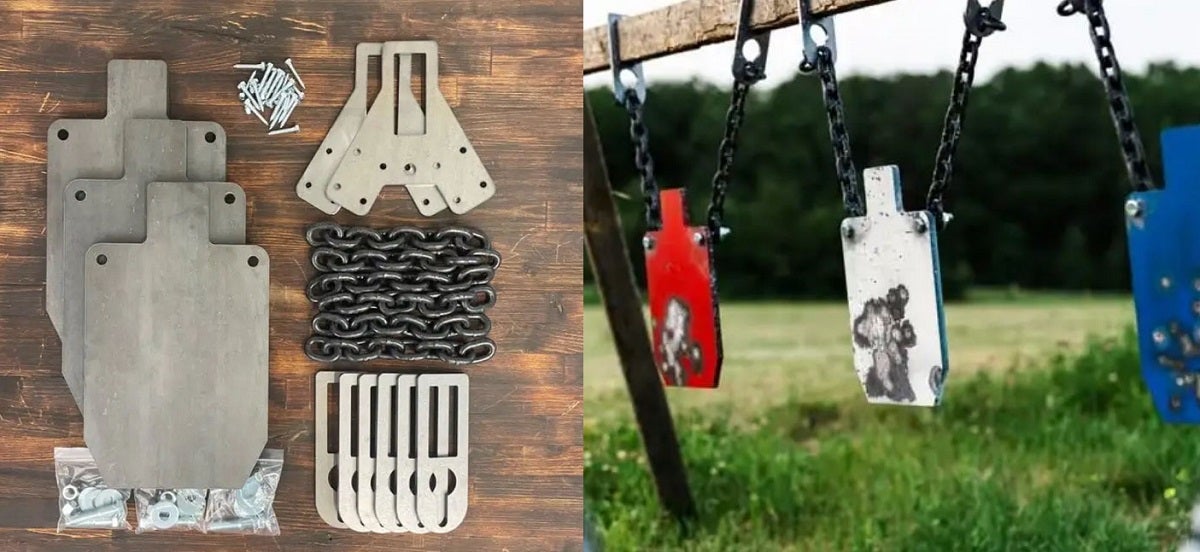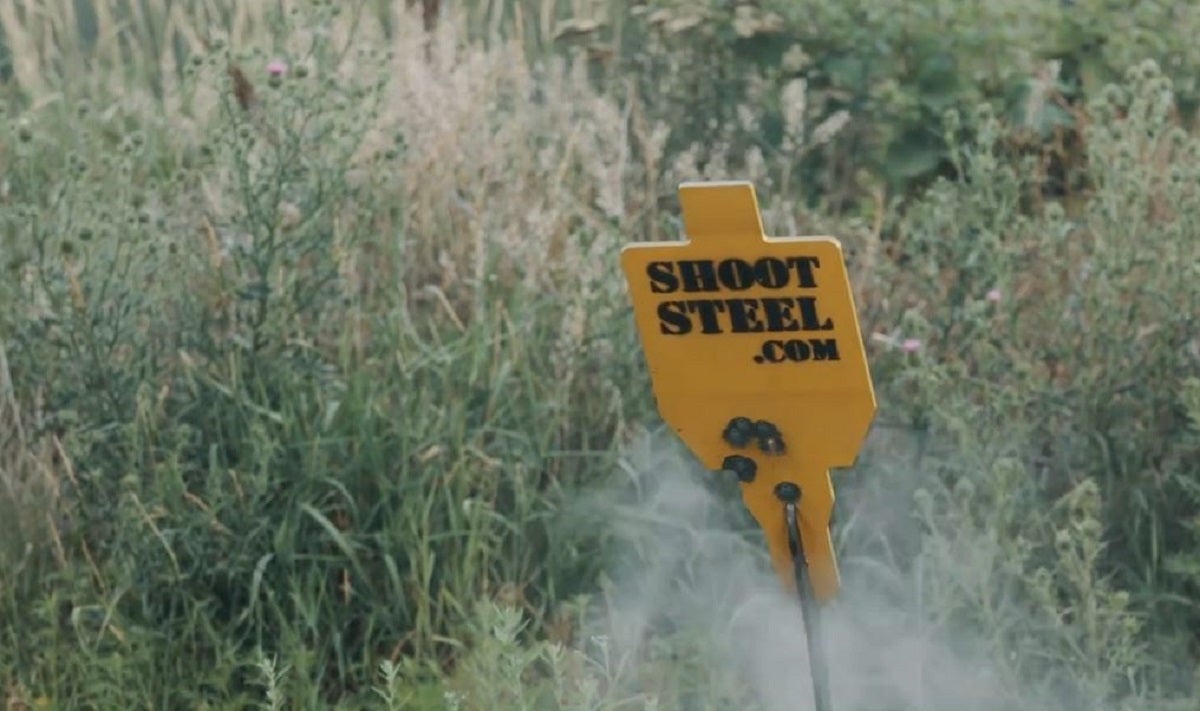The Guide to Steel Targets & How to Shoot Them Safely
Travis Olander 12.14.23

Targets are expensive, and they don’t last unless — well, most of them suffer these two problems, at least. But not steel. Hardened steel targets can, when used properly, last literally forever. They’ll take thousands of hits from handguns and even magnum-caliber rifle cartridges, shrugging off all the copper and lead you can sling at them.

A steel rifle target angled to eliminate ricochet risks; more on that later. Courtesy ShootSteel.com
But steel targets come with plenty of caveats. Using the wrong steel for a particular caliber can mean you’ll wind up punching holes in your shiny, expensive plate. At worst, setting up a steel target incorrectly can be lethal. Take, for example, this infamous video of a .50 BMG ricocheting off some steel targets downrange in the desert. The offending shooter’s lucky he only lost his earmuffs.
What are steel targets made from?
All steel targets are made from through-hardened steel alloys, most commonly AR500 and AR550, the latter being harder and more capable of handling higher calibers. The “AR” stands for Abrasion Resistant, while the 500 and 550 digits are meant to denote the estimated Brinell Hardness Numbers (BNH) of each steel. It’s these high hardness ratings that account for these steels’ ability to withstand repeated high-velocity impacts from live rounds.
Although there are different AR-type hardened steels, like AR400, and AR700, it’s AR500 and AR550 that denote the “sweet spot” for making reliable, reusable steel targets. Softer steels can’t withstand the impacts of rounds without deforming, while harder steels are too brittle, and could crack or fissure when used as target material.
What’s the biggest caliber you can shoot at steel targets?
It’s generally accepted that .30-caliber magnum rifle rounds (like .300 Win Mag and .338 Lapua) and .50 BMG represent the limits of what’s safe when shooting steel.
Steel target sizes by caliber
Steel targets come in different thicknesses, which are designed to handle certain ranges of calibers. Follow these guidelines when picking out steel targets to ensure you’re not shooting at an alloy that’s too thin — lest you wind up with a ruined target after a few magazines.
1/4″ AR500
Quarter-inch AR500 is suitable for all rimfire calibers, some shotgun rounds, and most centerfire handgun cartridges, excluding magnum loads. These include: .22, .25, .32, .380, 9mm, .40 S&W, and .45 ACP, and for shotguns, .410 shells.
3/8″ AR500
Three-eighths AR500 is suitable for magnum handgun rounds and all centerfire rifle rounds up and including .308 Win. This is the thickness you want for all your typical intermediate rifle rounds, like .223 and 5.56 NATO, .243, and 7.62×39, larger rounds like .30-06, and larger shot shells, including 20- and 16-gauge.
1/2″ AR500
You’ll want half-inch steel for all the shoulder bruisers, including those .30-cal magnums we mentioned, and 12-gauge shot shells. Of course, half-inch will be more than adequate — if not overkill — for all the cartridges reserved for thinner steel, too.
3/4″ AR500
These are reserved for repeated .50 BMG impacts and heavy-game cartridges, like 416 Rigby. If you’re shooting wrist-breaking handguns, like the Model S&W500, you’ll probably want to stick with these thick plates, too.
(What about AR550?)
No steel target is truly immortal. After hundreds of rounds, the pock marked surface of your target will begin to fatigue the metal within, and the steel may begin to develop cracks and fissures. Using AR550 instead of AR500 steel simply delays this inevitability by providing a harder strike face that’ll last longer.
If you’re shooting exclusively magnum rifle rounds, 12-gauge slugs, and other heavy hitters — and you want your steel targets to last as long as possible — then investing in AR550 instead of AR500 is the key.
How to Safely Shoot Steel Targets
Steel targets are, indeed, potentially dangerous if not used properly. Follow these steps to ensure you’re not catching shrapnel (or a round that winds up returning to its sender).
Always Angle Fixed Steel Targets Downward
A 15-degree angle is the minimum, here. Angling the target downward like this will direct most spalling into the dirt below, and any ricochets will simply pile in the ground below, too. If you’re shooting steel at close range — within 50 meters, which is usually the case with handgun rounds — then a 45-degree angle is highly recommend.
Targets held by chains don’t require any angling games — and, well, they technically can’t be angled down. They’ll simply hang vertically, but that’s OK. The energy of the impact is absorbed by the target’s own movement backward, which reduces the distance that spelling is thrown. Ricochets are also significantly less likely to occur when you’re shooting at hung steel targets.
Never use steel core, incendiary, or AP rounds on steel
Firing AP rounds at hardened steel is going to dramatically increase the chances of the steel target shattering and sending dangerous shrapnel in all directions. Steel core ammo will have similar effects, and those cores are highly likely to ricochet with greater energy and distance than a wayward copper jacket. Incendiary rounds make a pretty dramatic splash when fired at steel, but this creates a major fire hazard and is best avoided.
Minimum distance for rifle rounds is 100 yards
Firing at steel targets with rifle rounds at any shorter distance will increase the risks of injury from spalling, shrapnel, and ricochets, and the life of the target will be dramatically reduced.
Minimum distance for handgun rounds is 10 yards
The same logic holds true here, too: Give yourself a minimum distance of 10 yards when shooting handgun rounds at steel, and ensure you’re angling your targets downward to prevent close-range injuries.
Need a good standing silhouette steel target? Check out our review of the Grizzly Targets 3/8″ Reactive Target. KRATE Tactical has some cool “Deck of Cards” Steel Targets; click the link to check ’em out.